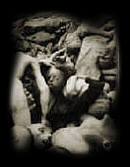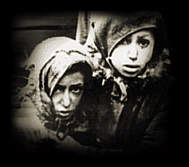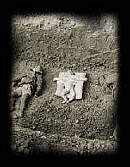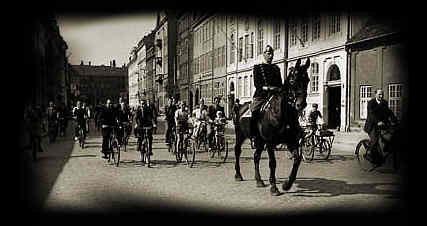





|
The Holocaust of WW2 is certain to be remembered as humanity's blackest chapter of the century - between 1941 and 1945, German dictator Adolf Hitler and his Nazis murdered some 6 million Jews. Amidst the madness of war, there are moments of hope and illumination. In World War II, one such instance was the Danish Jews’ escape from Hitler’s genocidal plan to eradicate all Jews from Europe. The nobility of the human soul on a night when the Danes got truly fed up with the führer ... |

Danish Jews reached safety ..
It's one of the great untold stories of World War II: In 1943, in German-occupied Denmark, the Danish people find out that all 7,500 Danish Jews are about to be rounded up and deported to German concentration camps. Danish citizens spontaneously make their own decision: it's not going to happen. And it didn't. Risking their own lives, the Danes quickly rallied round to save their fellow citizens, and almost all of the country's Jews were able to escape the clutches of the Nazis and find refuge in neutral Sweden.
In 1941, in the midst of World War II, the Germans began their "Final Solution" for the Jews. At that time there were 10 million Jews in the countries of German-occupied Europe. By 1945, less than half of that number were left alive. The Nazi goal was to exterminate the Jews and rule Europe in an ethnically "pure" German Empire.
At the infamous Wannsee Conference near Berlin 20 January 1942, details of the mass murder plans were discussed. Documents from that conference are still in existence today. They list, country by country, the number of Jews in Europe. Against the entry for Denmark is the figure 5,600-the inaccurate Nazi estimate of the number of Jews in Denmark.



Final
Solution: Auschwitz
Bergen-Belsen
Belzec
Sobibor
Treblinka
Denmark was a small idyllic country of 4 million people, with a history of taking in immigrants from countries such as Germany, Holland, Sweden, and Poland. Before the war, Denmark's small Jewish population was well integrated into the community.
On April 9, 1940, Germany attacked Denmark. From then until 1945, Denmark was under German occupation. Most Danes were pro-British and anti-Nazi, but they were also aware of the need to adjust to living in a German-dominated Europe. Danes and Germans quickly worked out the terms of occupation. King Christian X remained in Denmark, unlike his fellow monarchs in Norway and the Netherlands who fled to escape the Germans and establish resistance movements in England. The Danish government continued to rule. The Danes agreed to supply rich agricultural produce and other goods to the Germans.
By the following year, however, a Danish resistance movement had begun, but it made little headway until 1943. Then the mood in Denmark began to change. German military targets and businesses working for the occupiers were hit by a wave of sabotage actions. There was also labor unrest, with massive strikes - widely supported by the populace - in many Danish cities.

The King on
his horse, followed by Danish citizens on bicycles
The legend says that when the Germans ordered Jews in
occupied Denmark to identify themselves by wearing armbands with yellow stars, King
Although the Danes did undertake heroic efforts to
shelter their Jews and help them escape from the Nazis, there is no real-life
example of the actions described by this legend. Danish citizens never wore the
yellow badge, nor did King Christian ever threaten to don it himself. In fact,
Danish Jews never wore the yellow badge either, nor did German officials ever issue an
order requiring Danish Jews to display it.
But the Danes engaged in symbolic gestures of
defiance against their occupiers, such as wearing four coins tied together with
red and white ribbons in their buttonholes. Red and white are the Danish colors,
and four coins totalling nine ore represented the date of the occupation,
|
|
|
In
the book Queen in Denmark by Anne Wolden-Ræthinge the Danish Queen
Margrethe II says about the legend:"It
is a beautiful and symbolic story, but it is not true. The myth about the King
wearing the star of David ... I can imagine that this could have originated from
a typical remark by a Copenhagen errand boy on his bicycle: 'If they try to
enforce the yellow star here, the King will be the first to wear it!' To me, the
truth is an even greater honor for our country than the myth."
King Christian
X became a prominent figure for the real
views of the majority of the Danish population. The King made it his practice to
ride his horse alone through Copenhagen every morning to underline his
continuing claims for national sovereignty, unarmed and without escort. He
became a national symbol for rich and poor alike, a positive contrast to German
militarism and to the cult of the Fuhrer. In fact King Christian rejected many
aspects of the occupation, made speeches against the occupying force and became
known as a protector of the Jews.
In
December 1941, after an arson at the synagogue in Copenhagen, he sent a letter
of sympathy to Rabbi Marcus Melchior. The welfare of the Danish Jews was of
great importance to the king and the Danish government. "There is no
Jewish question in Denmark" were the words of Foreign Minister Erik
Scavenius to the German top Nazi Hermann Goring in autumn 1941.
Tales of King Christian's snubbing of Hitler and the Nazis
(some true
and some apocryphal) began to circulate. When Hitler sent a letter of
congratulations to King

August 1943: Danish adaption to German occupation turned to resistance
In August, 1943, a state of emergency was declared in Denmark, and the Nazis decided that they could now move against the Jews. In September Hitler approved the deportation of the Danish Jews. Werner Best of the SS, Hitler's chief in Denmark, received the final order to proceed with deportation of Jews to death camps, on Sept.28, 1943. The Nazis were prepared to deport the 7,500 Jews, starting at 10 PM. on Oct.1, 1943. Georg F. Duckwitz, a German maritime attaché, leaked out the order to Hans Hedtoft a Danish Social Democrat, who in turn warned C.B. Henriques, the head the Jewish Community.
On September 29th, two days before the projected round up on Rosh HaShannah, the Jewish New Year, Dr. Marcus Melchior, the acting chief Rabbi of the Krystalgaade Synagogue, implored his stunned congregants and the whole Jewish community to go into hiding immediately. Two German passenger ships, docked in Copenhagen’s port, were ready to ship approximately 5,000 Jews to Germany on their way to kz camp Theresienstadt. Buses were to take the remaining 2,500.
The word was passed and many Danes offered their support, conveying warnings and finding places for the Jews to hide. Danes felt that persecution of minorities was a breach of Danish culture and they were not prepared to stand for it.

Danish Jews’ escape from Hitler’s genocidal plan
From all strata of Danish society and in all parts of the country, clergymen, civil servants, doctors, store owners, farmers, fishermen and teachers protected the Jews. A united Lutheran Church openly and persistently challenged the German offensive. Many Torahs from Rabbi Melchior’s synagogue were hidden a few blocks away in the crypt of Trinity Church. Dr. Koster, who was in charge of Bispebjerg Hospital, was instrumental in arranging for hundreds of Jews to be hidden at the hospital before they made their escape to Sweden. The psychiatric building and the nurses' quarters were filled with refugees, who were all fed from the hospital kitchen. Virtually the entire medical staff at the hospital cooperated to save Jewish lives. Once it became known among Danes what the hospital was doing, money was donated from all over the country.
The Danish police and coast guard also took sides with the oppressed by refusing to assist in the manhunt. Not to mention the Wehrmacht soldiers, some of whom looked the other way - moved by either compassion or bribes.
To make their escape, many refugees were driven to the coast in ambulances belonging to the hospital. Local fishermen agreed, for a price, to transport them to Sweden. But they weren't safe yet. Successfully completing the two-mile boat trip without being intercepted by German patrol boats was not easy.

Gilleleje
Gilleleje, one of the larger fishing harbours, lies at the northernmost point of the island of Zealand with train connections to Copenhagen. About one fifth of the Danish Jews escaped to Sweden via this village. Fishing boats as well as coastal freighters from the harbour took part. Jews were familiar with Gilleleje from summer holidays in the country and came to the area in droves. A committee of local people were quick to initiate rescue aid, even before representatives for the rescue groups in Copenhagen arrived. Many were needed to help find hiding places and food.
One of the survivors, Leif Wassermann, was only five years old when his family, including his parents, grandparents and younger sister, fled to their coastal summer home in Gilleleje. He later recalled how his father carried him down into the dark hull of the boat in the middle of the night, but he remembered the hushed voices, the cramped feeling as people crowded inside and the rotten smell of fish. They were rescued by Henny Sondig, the 19-year-old daughter of the boat manager, and the four-man crew of the the 20-ton lighthouse tender, named the Gerda III.
`We stayed very low on the floor. We heard there were German patrols outside. We saw flashlights going through the windows,´ Wassermann recalled. Although the Gerda III was regularly boarded by German soldiers, the refugees were never discovered. The boat made more than a dozen trips with groups of five to 20 people crammed inside the hull - thus saving many Jewish families from annihilation.Leif Wassermann and his family were not able to return to their homeland until May 5, 1945, when Denmark was liberated. Years later he was appointed vice consul and commercial attache of the Danish government in New York.



Adolf Eichmann and Werner Best
Over the course of a few days, more than 7,000 Danish Jews reached safety in Sweden. Only 481 were captured and sent to a Nazi prison at Theresienstadt. Conditions there were hard, but Theresienstadt was not a death camp. And The Danish acts of bravery did not end with those dramatic weeks in the fall of 1943. Danes continued to protect the unfortunate 481 Jews whom the Germans were able to capture. Danish officials convinced Adolf Eichmann via Werner Best to keep the Jews from Denmark away from Poland and the extermination camps. Best was interested in improving relations with the Danish authorities in light of the events in October. Eichmann was presumably hoping to present an idealized propaganda image to conceal the fact of mass genocide, which by 1943 had cost the lives of 3 million Jews.
Almost all of the Danish Jews in the camp survived through the solicitude and support of the Danish civil service and church organizations. Month after month, the Danes sent over 700 packages of clothing, food and vitamins to the Jews in the camp. In June 1944, at the insistence of the Danish leadership, the Danish Red Cross inspected Theresienstadt to ascertain the condition of their Jewish compatriots.

Danish fishermen saving Jews
The rescue of the Danish Jews is an inspiring story from a terrible time in human history. In most other Nazi-occupied countries, the Germans found it easy to deport the Jews. No one defended them the way the Danes did. Ninety-nine percent of the Jewish population was rescued and survived the war years, mostly in neutral Sweden and a few hundred in Theresienstadt under the distant but constantly protective concern of the Danes.
Denmark was also different and special in another way. Almost everywhere else in Europe, returning Jews found their homes had been broken into, and everything of value stolen. When the Danish Jews returned , they discovered that their homes, pets, gardens and personal belongings were cared for by their neighbors.

Georg Duckwitz honored by Israel
Werner Best was arrested when Denmark was liberated in 1945, his death sentence was reduced to 12 years in jail, by Denmark's Supreme Court, he died in 1989. Georg Duckwitz after the war served as Germany's Ambassador to Denmark and was honored by Israel for his part in the rescue of Jews, he died in 1973. Mr. Hans Hedtoft, the Danish politician and statesman, served as postwar Prime Minister of Denmark.

Hans Hedtoft
Hans Hedtoft was instrumental in saving the Danish Jews. As secretary of the Social Democratic party in 1935 Hans Hedtoft was elected to Parliament, but he resigned his seat in 1940, during the German occupation of Denmark in WWII. A member of the Danish resistance movement, Hedtoft became minister of social affairs in the first postwar government in 1945. He headed a Social Democratic government in 1947-50. Hedtoft again became prime minister in 1953, but died in Stockholm that year while attending a meeting of the Nordic Council.
In Jerusalem, a boat-like monument was erected on the 25th anniversary of the rescue of Danish Jewry, and a school was named in Denmark's honor. Many cities and towns in Israel have a street or square commemorating the heroism of the Danes. Moreover, one of the prominent items on display in Yad Vashem, the Holocaust Memorial in Jerusalem, is a small boat that was used to ferry Jews to safety in Sweden. The boat is situated near the Righteous Alley, signifying rescue, hope, life - and trust in the human spirit. Its display is a tribute to the Danes who made the difference during the most tragic period in the last century.
In
Copenhagen's Israelplads there is a monument from Eilat stone with an
inscription in both Danish and Hebrew, a gift of the people of Israel. King
Christian X' grandchild, Denmark's Queen Margrethe II, was the patron of the
events marking the 50th anniversary of the rescue operation of Danish Jews.
Vilhelm Leifer - Den Danske Schindler

|
|
|
|
|
|
Adolf Hitler's SS Men Hitler surrounded himself with a small clique of fanatical, ruthless henchmen - a violent group of outsiders who rose to power in the Third Reich and established political and economic institutions of legitimized terror. These masterminds of death were found to be quite psychologically normal. They were men of fine standing, husbands who morning and night kissed their wives, fathers who tucked their children into bed. But murders, brutalities, cruelties, tortures, atrocities, and other inhuman acts were an everyday occurrence. The European Jews were the primary victims of the Nazis. In 1933 nine million Jews lived in the 21 countries of Europe that would be occupied by Germany during the war. By 1945 two out of every three European Jews had been killed. But Jews were not the only group singled out for persecution by Hitler's Nazi regime. One-half million Gypsies, 250,000 mentally or physically disabled persons, and more than three million Soviet prisoners-of-war also fell victim to Nazi genocide. Jehovah’s Witnesses, homosexuals, Social Democrats, Communists, partisans, trade unionists, and Polish intelligentsia were also victims of the hate and aggression carried out by the Nazis. |
www.auschwitz.dk www.oskarschindler.com www.emilieschindler.com www.shoah.dk
© 2015-2017
Louis Bülow Privacy
All Rights Reserved.